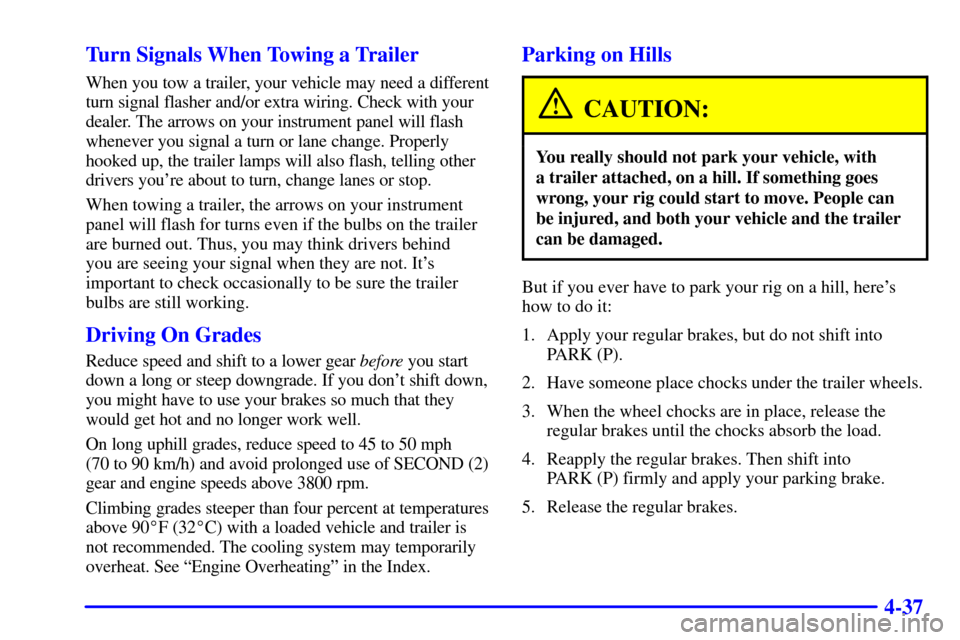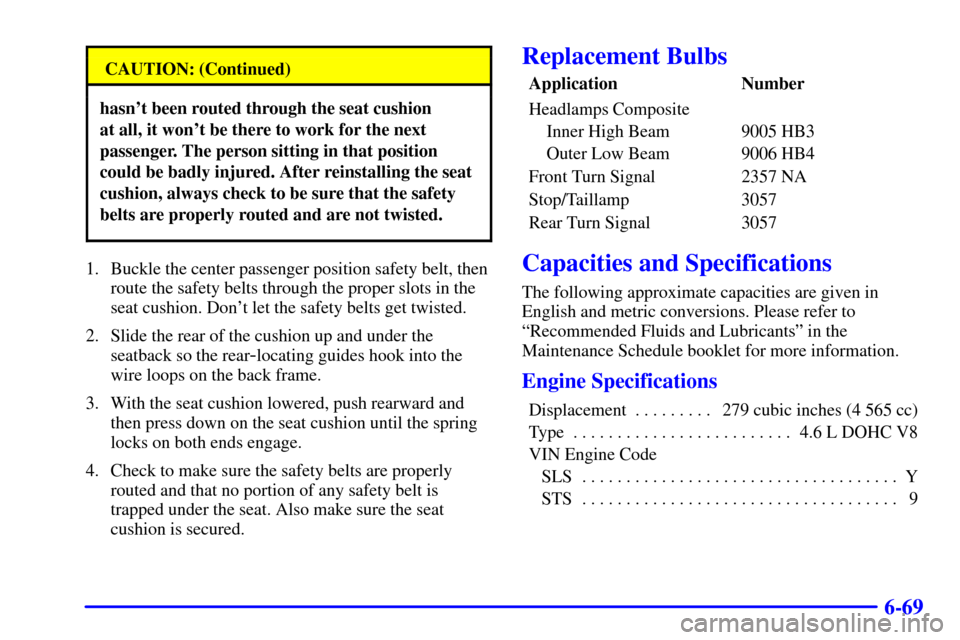Page 96 of 359

2-36
Turn Signal/Multifunction Lever
Turn and Lane Change Signals
To signal a turn, move the lever on the left side of the
steering wheel all the way up or down. The lever returns
automatically when the turn is complete.
An arrow located on the
instrument panel cluster
will flash in the direction
of the turn or lane change.
Raise or lower the lever until the arrow starts to flash to
signal a lane change. Hold it there until the lane change
is complete. The lever returns when it is released.
If the turn signal is left on, a warning chime will sound
and the Driver Information Center (DIC) will display
TURN SIGNAL ON (after driving about a mile) to
remind you to turn it off.Arrows that flash rapidly when signaling for a turn or
lane change may be caused by a burned
-out signal bulb.
Other drivers won't see the turn signal.
Replace burned
-out bulbs to help avoid possible
accidents. Check the fuse (see ªFuses and Circuit
Breakersº in the Index) and check for burned
-out
bulbs if the arrow fails to work when signaling a turn.
Headlamp High/Low Beam
When the low-beam headlamps are on, push the turn
signal lever away from you to change the headlamps to
high beam.
This light on the
instrument panel cluster
will be on, indicating
high
-beam usage.
Pull the turn signal lever toward you to return to
low
-beam headlamps.
Page 247 of 359

4-37 Turn Signals When Towing a Trailer
When you tow a trailer, your vehicle may need a different
turn signal flasher and/or extra wiring. Check with your
dealer. The arrows on your instrument panel will flash
whenever you signal a turn or lane change. Properly
hooked up, the trailer lamps will also flash, telling other
drivers you're about to turn, change lanes or stop.
When towing a trailer, the arrows on your instrument
panel will flash for turns even if the bulbs on the trailer
are burned out. Thus, you may think drivers behind
you are seeing your signal when they are not. It's
important to check occasionally to be sure the trailer
bulbs are still working.
Driving On Grades
Reduce speed and shift to a lower gear before you start
down a long or steep downgrade. If you don't shift down,
you might have to use your brakes so much that they
would get hot and no longer work well.
On long uphill grades, reduce speed to 45 to 50 mph
(70 to 90 km/h) and avoid prolonged use of SECOND (2)
gear and engine speeds above 3800 rpm.
Climbing grades steeper than four percent at temperatures
above 90�F (32�C) with a loaded vehicle and trailer is
not recommended. The cooling system may temporarily
overheat. See ªEngine Overheatingº in the Index.
Parking on Hills
CAUTION:
You really should not park your vehicle, with
a trailer attached, on a hill. If something goes
wrong, your rig could start to move. People can
be injured, and both your vehicle and the trailer
can be damaged.
But if you ever have to park your rig on a hill, here's
how to do it:
1. Apply your regular brakes, but do not shift into
PARK (P).
2. Have someone place chocks under the trailer wheels.
3. When the wheel chocks are in place, release the
regular brakes until the chocks absorb the load.
4. Reapply the regular brakes. Then shift into
PARK (P) firmly and apply your parking brake.
5. Release the regular brakes.
Page 317 of 359
6-41 Front Turn Signal Lamps
1. The turn signal lamps are located on the outboard side
of the headlamps. To access, remove the headlamp,
(see Steps 1, 2 and 3 under ªHeadlampsº).
2. Press the bulb socket tab and turn the bulb socket
counterclockwise to unlock the socket from the
lamp housing.
3. To remove the bulb, grasp the socket firmly and
pull the bulb out. Install the new bulb and reverse
the steps to replace.
Rear Turn Signal Lamps and Taillamps
1. Open the trunk to gain access to the lamp housing.
2. Remove the rear
compartment sill plate
by removing the upper
convenience net
retainers, located at
each end, as shown.
3. Move the spare tire cover out of the way.
4. Pull the trunk trim away to access the wing nuts.
Page 318 of 359
6-42
5. Remove the three wing nuts that fasten the taillamp
to the body.
6. Gently remove the taillamp from the body. The
taillamp is on the bottom of the housing and the rear
turn signal lamp is on the upper part of the housing.7. Press the bulb socket tab and turn the socket
counterclockwise to remove it. To remove the bulb,
grasp the socket firmly and pull the bulb out.
Once you have replaced the burned
-out bulb, reverse the
steps to reassemble the lamp assembly.
Page 345 of 359

6-69
CAUTION: (Continued)
hasn't been routed through the seat cushion
at all, it won't be there to work for the next
passenger. The person sitting in that position
could be badly injured. After reinstalling the seat
cushion, always check to be sure that the safety
belts are properly routed and are not twisted.
1. Buckle the center passenger position safety belt, then
route the safety belts through the proper slots in the
seat cushion. Don't let the safety belts get twisted.
2. Slide the rear of the cushion up and under the
seatback so the rear
-locating guides hook into the
wire loops on the back frame.
3. With the seat cushion lowered, push rearward and
then press down on the seat cushion until the spring
locks on both ends engage.
4. Check to make sure the safety belts are properly
routed and that no portion of any safety belt is
trapped under the seat. Also make sure the seat
cushion is secured.
Replacement Bulbs
Application Number
Headlamps Composite
Inner High Beam 9005 HB3
Outer Low Beam 9006 HB4
Front Turn Signal 2357 NA
Stop/Taillamp 3057
Rear Turn Signal 3057
Capacities and Specifications
The following approximate capacities are given in
English and metric conversions. Please refer to
ªRecommended Fluids and Lubricantsº in the
Maintenance Schedule booklet for more information.
Engine Specifications
Displacement 279 cubic inches (4 565 cc). . . . . . . . .
Type 4.6 L DOHC V8. . . . . . . . . . . . . . . . . . . . . . . . .
VIN Engine Code
SLS Y. . . . . . . . . . . . . . . . . . . . . . . . . . . . . . . . . . . .
STS 9. . . . . . . . . . . . . . . . . . . . . . . . . . . . . . . . . . . .